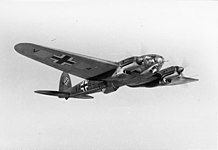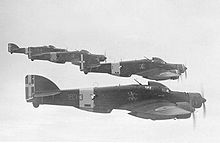Gondola (airplane)
Gondola is the general term for the usually-armored ventral casemate-style positions used on many World War II-era military bomber aircraft, especially on German designs,[1] where they were usually known as Bodenlafette, often shortened to Bola[2] (from German Boden, 'floor', + Lafette 'gun carriage or mounting', from French l'affût, gun carriage).
Gondolas were either used to house a gunner or a bombardier.
Gallery[]
Examples of gondolas on World War II military aircraft:
 Heinkel He 111H bomber with its bola gondola just behind the bomb bay |
 Junkers Ju 88A bomber's nose, clearly showing the classic bodenlafette, or bola, undernose form of gondola fitted, in one form or another, to almost all German bomber designs of World War II |
 B-17D Flying Fortress of 1940, having its "bathtub" gondola in virtually the same location as the He 111H |
 Heinkel He 177As, with the foreground aircraft's nose prominently showing the bulky bola under the cabin |
 A flight of four Italian Savoia-Marchetti SM.79 Sparviero trimotor bombers, each with a similar gondola behind the bomb bay, but primarily used for the bombardier on this design, because of the nose-mounted engine taking up a bombardier's usual location |
See also[]
Other types of aircraft equipped with gondolas:
- Airship
- Balloon (aircraft)
References[]
- ^ Kay, Anthony L.; Smith, John Richard (2002). German Aircraft of the Second World War: Including Helicopters and Missiles. Naval Institute Press. ISBN 978-1557500106. Retrieved July 1, 2014.
- ^ Stedman, Robert F. (2012). Kampfflieger: Bomber Crewman of the Luftwaffe 1939-45. Osprey Publishing. ISBN 978-1782006633. Retrieved July 1, 2014.
Categories:
- Aircraft weapons
- Military aviation stubs